MNSR 25 - Sense Organs: Mechanoreceptors and Chemoreceptors
0.0(0)
0.0(0)
Card Sorting
1/22
Earn XP
Description and Tags
Study Analytics
Name | Mastery | Learn | Test | Matching | Spaced |
|---|
No study sessions yet.
23 Terms
1
New cards

internally and externally, ur wired for sensation :)
2
New cards
what are sensory receptors
what are some general senses and what are they important in maintaining
what are some general senses and what are they important in maintaining
* Input into the nervous system is provided by the **sensory receptors**;
\
* These are nerve endings or specialised cells which convert **stimuli** from the external and internal environment into **afferent** nerve impulses which pass into the CNS;
\
* **SENSE organs** of the body include the **EYE** \[optic\] and the **EAR** \[auditory\];
\
* Though important, the major senses only provide us with a part of our **sensory information**;
\
* The other two special senses, **TASTE** and **SMELL** together with the **GENERAL** **SENSES** such as light touch, pressure, temperature, pain and a sense of body and limb position are of major importance in maintaining **homeostasis**
\
* These are nerve endings or specialised cells which convert **stimuli** from the external and internal environment into **afferent** nerve impulses which pass into the CNS;
\
* **SENSE organs** of the body include the **EYE** \[optic\] and the **EAR** \[auditory\];
\
* Though important, the major senses only provide us with a part of our **sensory information**;
\
* The other two special senses, **TASTE** and **SMELL** together with the **GENERAL** **SENSES** such as light touch, pressure, temperature, pain and a sense of body and limb position are of major importance in maintaining **homeostasis**
3
New cards
what are the 5 functional categories of sensory receptors
note, there is **no** entirely satisfactory system of classification which incorporates both functional and morphological features
\
1. %%**MECHANORECEPTORS**%% - these detect mechanical stimulation
Free nerve endings inervate base of hair follicles - u feel a fruit fly land on u in the summer (light touch for Merkel cells)
\
2. %%**THERMORECEPTORS**%% - these detect changes in temperature (Krause’s endbulbs/corpuscles)
Blow on forearm, feel heat, thermoreceptors, u’ll detect cold much faster than heat bc those receptors are much closer to the top of skin
\
3. %%**NOCICEPTORS**%% (**Pain**) - these are all free nerve endings (pinching, tearing, burning) (pinching skin triggers nociceptors)
\
4. %%**PHOTORECEPTORS**%% - the rods and cones of the retina;
\
5. %%**CHEMORECEPTORS**%% - responsible for the senses of taste and smell;
\
1. %%**MECHANORECEPTORS**%% - these detect mechanical stimulation
Free nerve endings inervate base of hair follicles - u feel a fruit fly land on u in the summer (light touch for Merkel cells)
\
2. %%**THERMORECEPTORS**%% - these detect changes in temperature (Krause’s endbulbs/corpuscles)
Blow on forearm, feel heat, thermoreceptors, u’ll detect cold much faster than heat bc those receptors are much closer to the top of skin
\
3. %%**NOCICEPTORS**%% (**Pain**) - these are all free nerve endings (pinching, tearing, burning) (pinching skin triggers nociceptors)
\
4. %%**PHOTORECEPTORS**%% - the rods and cones of the retina;
\
5. %%**CHEMORECEPTORS**%% - responsible for the senses of taste and smell;
4
New cards
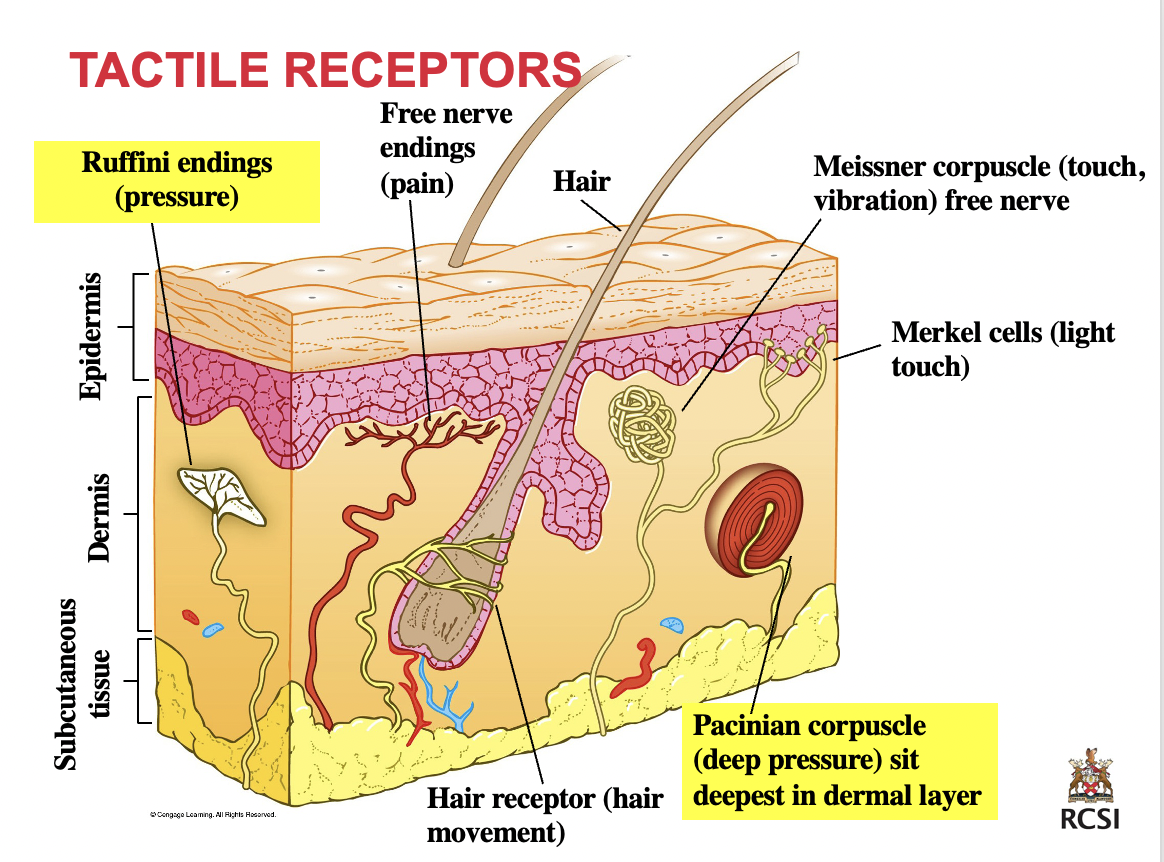
Mechanoreceptors!
* the most varied
\
* include **free nerve endings, tactile hair cells** and complicated **ENCAPSULATED END-ORGANS**
\
* **NAKED NERVE ENDINGS** are the ends of dendrites of sensory neurons in tissues, detect pain, temp and light touch
\
* encapsulated receptors consist of nerve endings surrounded by *1+ layers of cells*
\
* You have may have heard about the **HAIR CELLS** in the **Ear** (Organ of Corti**,** crista ampullaris) but mechanoreceptors may be found in many parts of the body such as the skin, muscle, gut.
______________
**Figure 43-4 Sensory receptors in human skin**
(a) Mechanoreceptors in human skin. This diagrammatic section through the human skin illustrates several types of mechanoreceptors that
respond to touch and pressure. Also shown are free nerve endings that respond to pain.
\
Ruffini and Pacinian r 2 of 3 encapsulated nerve endings
\
* include **free nerve endings, tactile hair cells** and complicated **ENCAPSULATED END-ORGANS**
\
* **NAKED NERVE ENDINGS** are the ends of dendrites of sensory neurons in tissues, detect pain, temp and light touch
\
* encapsulated receptors consist of nerve endings surrounded by *1+ layers of cells*
\
* You have may have heard about the **HAIR CELLS** in the **Ear** (Organ of Corti**,** crista ampullaris) but mechanoreceptors may be found in many parts of the body such as the skin, muscle, gut.
______________
**Figure 43-4 Sensory receptors in human skin**
(a) Mechanoreceptors in human skin. This diagrammatic section through the human skin illustrates several types of mechanoreceptors that
respond to touch and pressure. Also shown are free nerve endings that respond to pain.
\
Ruffini and Pacinian r 2 of 3 encapsulated nerve endings
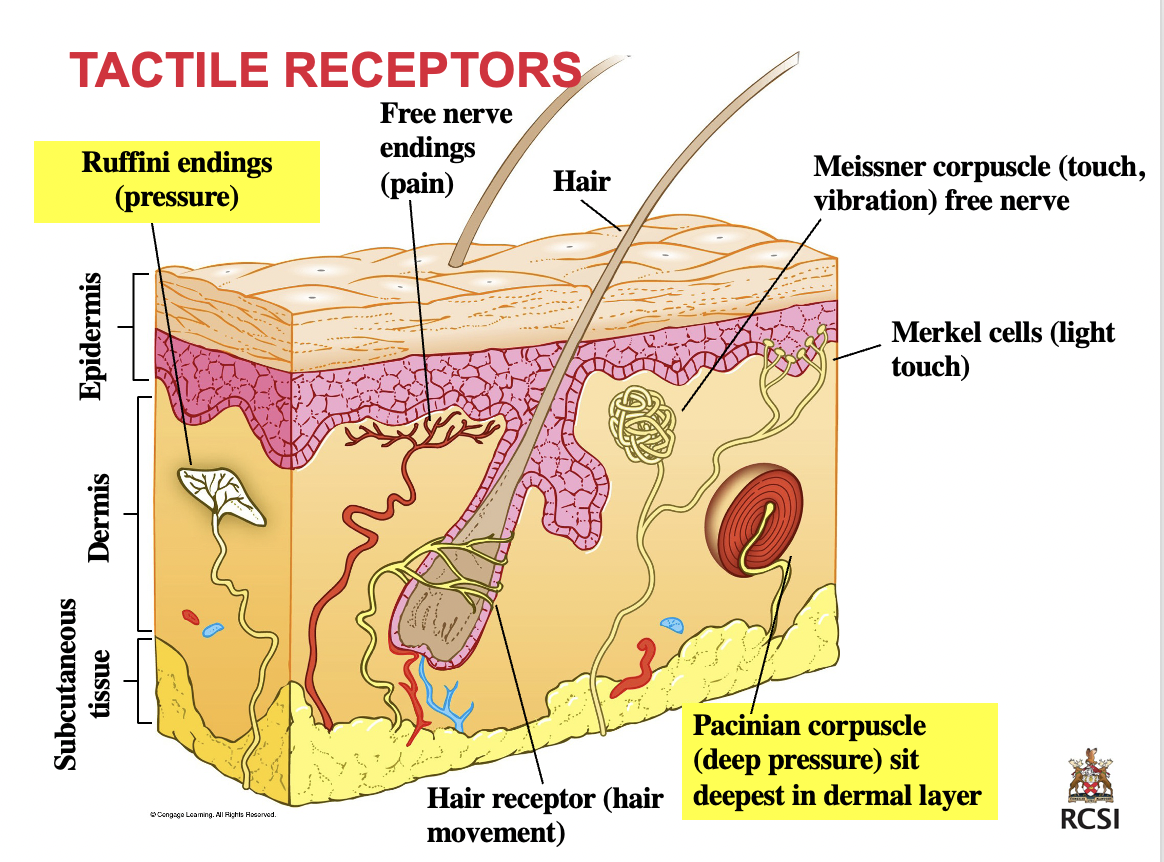
5
New cards
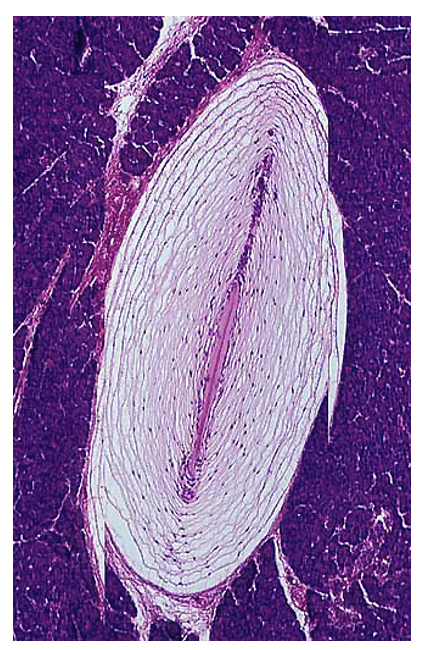
Mecanoreceptors - **pacinian corpuscles**
fast or slow adapting? fire short term or longterm after original stimulus?
fast or slow adapting? fire short term or longterm after original stimulus?
* sense **deep pressure**
* They have been compared to a small onion pierced by a thin wire;
* They are the Largest encapsulated nerve ending
* Consist of a naked nerve ending surrounded by numerous concentric cell layers
* Pressure transmitted to the naked nerve ending is thought to cause **Na+ ion channels** to open;
* this causes depolarisation in the nerve fibre
* Sructure in the middle is the NERVE ENDING everything surrounding are connective tissue fibers
* Very good at detecting \*\*vibration\*\* especially across an area, not very specific, have a \*receptor field\* that’s quite big
* Pressure is transmitted to the naked nerve ending
* these pascinian corpuscles are fast adapting, only fires on presentation of stimulus, if u hold smthn for rly long u forget abt it, receptors stop firing
\
* They have been compared to a small onion pierced by a thin wire;
* They are the Largest encapsulated nerve ending
* Consist of a naked nerve ending surrounded by numerous concentric cell layers
* Pressure transmitted to the naked nerve ending is thought to cause **Na+ ion channels** to open;
* this causes depolarisation in the nerve fibre
* Sructure in the middle is the NERVE ENDING everything surrounding are connective tissue fibers
* Very good at detecting \*\*vibration\*\* especially across an area, not very specific, have a \*receptor field\* that’s quite big
* Pressure is transmitted to the naked nerve ending
* these pascinian corpuscles are fast adapting, only fires on presentation of stimulus, if u hold smthn for rly long u forget abt it, receptors stop firing
\
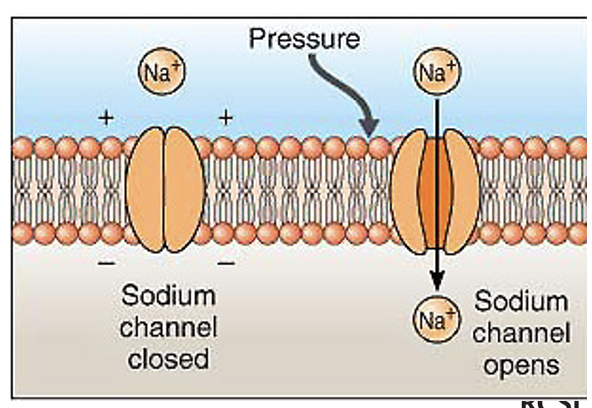
6
New cards
where are pascinian corpuscles found? what sets them aside form other encapsulated nerve endings
* Pacinian corpuscles are found in the **SUBDERMAL** skin layers, abdominal mesenteries, external genitalia, tendons, ligaments and joints;
* They respond to strong or rapid **movement** of the tissues, they are good detectors of **vibration**;
\
* this response is to the mechanical forces which cause movement in the tissues;
* this vibration acts on the **fluid** layer between the concentric layers of connective tissue in the corpuscle;
\
* They are the largest of the **encapsulated nerve endings** reaching lengths of 1 to 2 mm, and 0.5 mm in diameter;
* they consist of a central **non-myelinated** tip of a nerve fibre surrounded by up to 30 concentric layers of connective tissue;
* Pressure on nerve causing it to fire
* They respond to strong or rapid **movement** of the tissues, they are good detectors of **vibration**;
\
* this response is to the mechanical forces which cause movement in the tissues;
* this vibration acts on the **fluid** layer between the concentric layers of connective tissue in the corpuscle;
\
* They are the largest of the **encapsulated nerve endings** reaching lengths of 1 to 2 mm, and 0.5 mm in diameter;
* they consist of a central **non-myelinated** tip of a nerve fibre surrounded by up to 30 concentric layers of connective tissue;
* Pressure on nerve causing it to fire
7
New cards
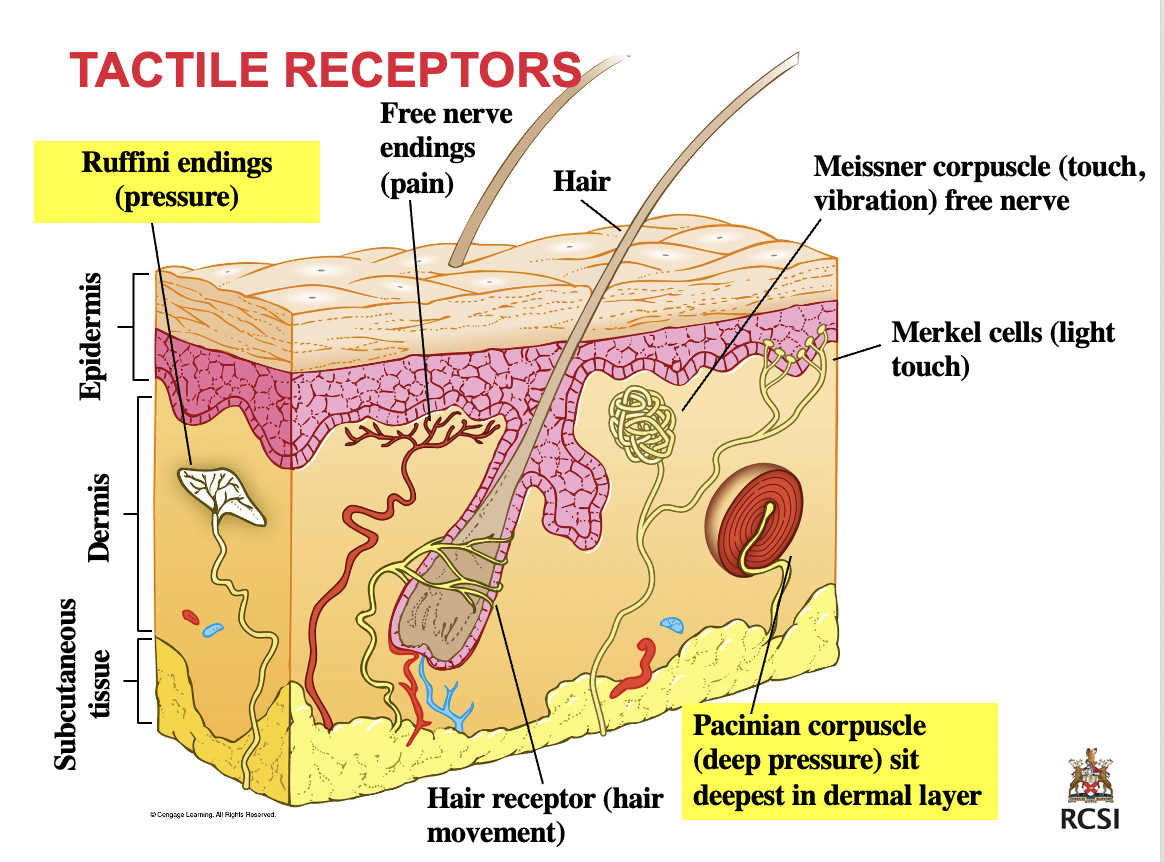
mechanoreceptors → **Ruffini’s end organs**
can be described how? found where? function?
can be described how? found where? function?
* Described by Ruffini in 1894 as *loosely* encapsulated nerve endings intermediate in size between Pacinian corpuscles and **Krause’s end bulbs**;
* In a loose connective tissue capsule, the **myelinated nerve fibres** *loose their sheaths* and @@break into a set of branches with terminal knobs@@;
* They are found in both the **DERMIS** and deeper organs such as joints;
* There has been disagreement as to their exact role, Ruffini thought they had a tactile function intermediate between Meissner’s (light touch) and Pacinian corpuscles (deep pressure);
* Later they were said to be thermoreceptors;
* %%Presently they are considered to be **slowly adapting** mechanical receptors responsive to __continuous__ deformation and distortion;%%
* In joint capsules they indicate the degree of **rotation**
* Less well understood, described over 100yrs ago
* Oblong capsule sitting within dermal layer, sits a biit higher than pascinian, loosely connected tissue capsule containing naked nerve ending, also found in \*\*joints\*\*!
\
* Ruffinis r SLOW adapting, as opposed to pascians
\
* Smone pulls on ur arm - ruffini
* In a loose connective tissue capsule, the **myelinated nerve fibres** *loose their sheaths* and @@break into a set of branches with terminal knobs@@;
* They are found in both the **DERMIS** and deeper organs such as joints;
* There has been disagreement as to their exact role, Ruffini thought they had a tactile function intermediate between Meissner’s (light touch) and Pacinian corpuscles (deep pressure);
* Later they were said to be thermoreceptors;
* %%Presently they are considered to be **slowly adapting** mechanical receptors responsive to __continuous__ deformation and distortion;%%
* In joint capsules they indicate the degree of **rotation**
* Less well understood, described over 100yrs ago
* Oblong capsule sitting within dermal layer, sits a biit higher than pascinian, loosely connected tissue capsule containing naked nerve ending, also found in \*\*joints\*\*!
\
* Ruffinis r SLOW adapting, as opposed to pascians
\
* Smone pulls on ur arm - ruffini
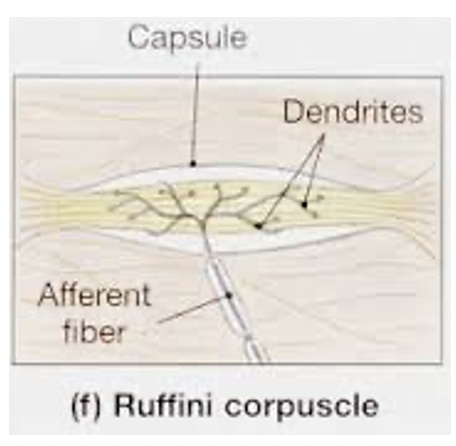
8
New cards
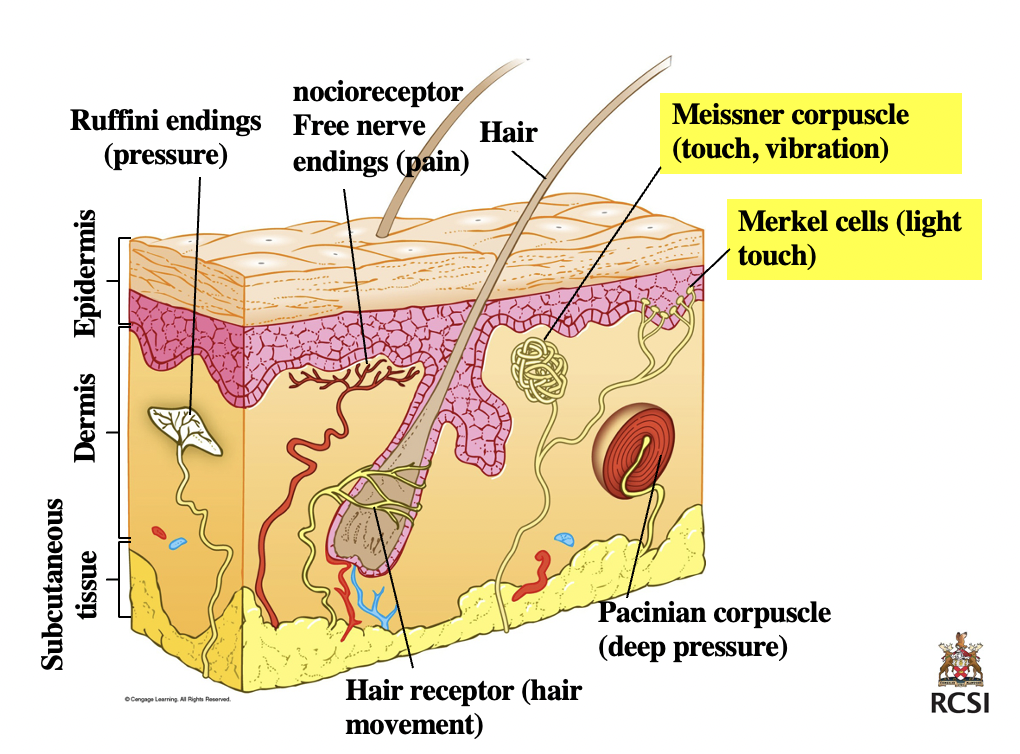
Mechanoreceptors → **Meissner’s Corpuscles**
found/concentrated where?
found/concentrated where?
* A common encapsulated sensory receptor, smaller than Pacinian corpuscles
* Oval receptors that contain two or three spiralling dendritic ends surrounded by a thin cellular capsule
* %%They are concentrated in the **DERMAL PAPILLAE** of the *fingertips, lips, palms of the hands, soles of the feet* and other sensitive areas of skin where the ability to detect a **light touch** sensation is important;%%
* They allow the body to recognise __what exact point__ has been touched;
* These smaller corpuscles are about 150mm long and 75mm wide and consist of *loose* stacks of lamellae surrounding **1 or 2 naked fibres**;
* Naked nerve endings encapsulated in an end organ
* Bc closer to skin much better at giving u details abt a more narrow surface area unlike pascian, is also very sensitive to PRESSURE
\
* Knowing where ur dragging ur finger on ur arm without looking is meissners
\
* More so detect movement of objects than pressure, that’s their speciality even though theyre great at pressure
\
* Super good at detecting light touch
* Oval receptors that contain two or three spiralling dendritic ends surrounded by a thin cellular capsule
* %%They are concentrated in the **DERMAL PAPILLAE** of the *fingertips, lips, palms of the hands, soles of the feet* and other sensitive areas of skin where the ability to detect a **light touch** sensation is important;%%
* They allow the body to recognise __what exact point__ has been touched;
* These smaller corpuscles are about 150mm long and 75mm wide and consist of *loose* stacks of lamellae surrounding **1 or 2 naked fibres**;
* Naked nerve endings encapsulated in an end organ
* Bc closer to skin much better at giving u details abt a more narrow surface area unlike pascian, is also very sensitive to PRESSURE
\
* Knowing where ur dragging ur finger on ur arm without looking is meissners
\
* More so detect movement of objects than pressure, that’s their speciality even though theyre great at pressure
\
* Super good at detecting light touch
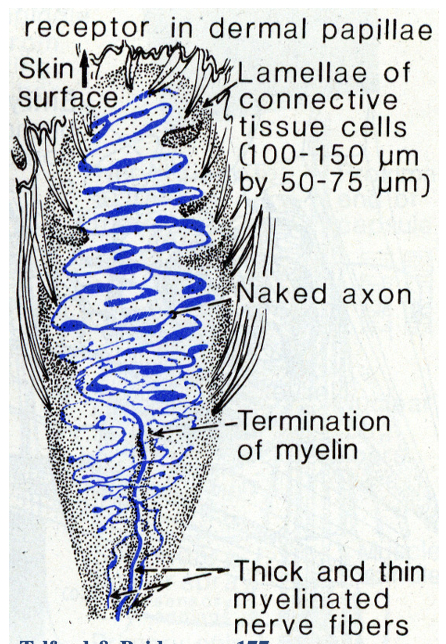
9
New cards
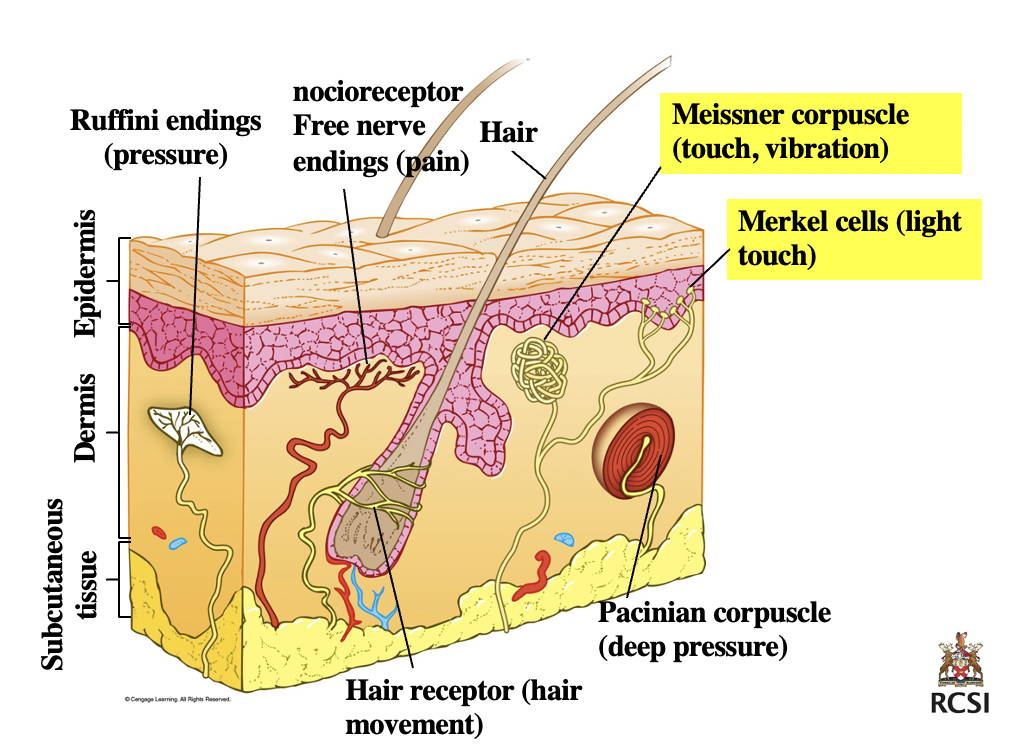
mechanoreceptors - merkel’s discs
found where
found where
* In the skin %%**EPIDERMIS** near the **stratum basale**%% are special cells called **Merkel cells**;
* Also called **expanded tip tactile receptors,** they are found in smooth but *less frequently* *in hairy skin*;
* They are thought to be concerned with **light touch sensations;**
* This structure consists of *small cup-shaped cells* and *naked nerve endings* that make contact with them
* Expanded discs at the base of the Merkel cells are connected via non-myelinated fibres to a single large **myelinated** nerve fibre;
* The Merkel cell cytoplasm contains vesicles similar to those found at synapses but ==no neurotransmitter has yet been found== ;)
* Also very very close to epidermis, has very narrow receptor field, give u super fine mechanoreception so u can maneuver fine tools like surgical tools bc ur so aware of **micromovements**
\
%%The nerve ending is like a hand connecting to multiple places, branches out%%
* Also called **expanded tip tactile receptors,** they are found in smooth but *less frequently* *in hairy skin*;
* They are thought to be concerned with **light touch sensations;**
* This structure consists of *small cup-shaped cells* and *naked nerve endings* that make contact with them
* Expanded discs at the base of the Merkel cells are connected via non-myelinated fibres to a single large **myelinated** nerve fibre;
* The Merkel cell cytoplasm contains vesicles similar to those found at synapses but ==no neurotransmitter has yet been found== ;)
* Also very very close to epidermis, has very narrow receptor field, give u super fine mechanoreception so u can maneuver fine tools like surgical tools bc ur so aware of **micromovements**
\
%%The nerve ending is like a hand connecting to multiple places, branches out%%
10
New cards
mechanoreceptors summary
* merkel’s disks
* meissner’s corpuscles
* Ruffini corpuscles
* pacinian corpuscles
\
give me size and shape of receptor (sharp or diffuse borders), give in what type of skin its found, the speed of adaptation to stimulus and what stimulus is *needed* to stimulate it :)
* merkel’s disks
* meissner’s corpuscles
* Ruffini corpuscles
* pacinian corpuscles
\
give me size and shape of receptor (sharp or diffuse borders), give in what type of skin its found, the speed of adaptation to stimulus and what stimulus is *needed* to stimulate it :)
Glabrous - found on naked skin - palms of hands, feet, not hairy arms and legs
\
Function in concert, brain is getting constant read out from all kinds of sensation
\
Habituation - u habituate the clothes on your body
\
Function in concert, brain is getting constant read out from all kinds of sensation
\
Habituation - u habituate the clothes on your body

11
New cards
**Proprioreceptors**
2 main types?
describe what structure is like
how often do they emit sensory nerve impulses?
2 main types?
describe what structure is like
how often do they emit sensory nerve impulses?
* Sense of position- no adaptation
* These receptors continually respond to tension and movement in *striated muscles* and in *tendons*
* There are two main types, %%**muscle spindles** and **Golgi tendon organs**%%;
\
* Each **MUSCLE SPINDLE** is about 2mm long and 0.5mm wide consisting of 3 to 10 small and specialised **muscle fibres** surrounded by a tangle of **sensory nerve endings (like wrapping barbed wire), they detect stretch in muscle and respond to it)** enclosed in a connective tissue sheath;
\
* They appear to emit **sensory nerve impulses** all the time and are probably more continually active than any other sensory receptors;
\
* %%Stretching the muscle increases the rate of firing%% thus muscle spindles continually monitor **muscle tone**;
\
Detects tension in a ligament
\
Muscle spindles, wev only got abt 50,000 in our body, most muscle have aby 50, up to 50, small muscles have less - these spindles are specialized muscles, 2mm long
\
\
Ur muscle receptors are constantly constantly active, but at a basal rate and when smthn changes is when they start firing at a faster rate
* These receptors continually respond to tension and movement in *striated muscles* and in *tendons*
* There are two main types, %%**muscle spindles** and **Golgi tendon organs**%%;
\
* Each **MUSCLE SPINDLE** is about 2mm long and 0.5mm wide consisting of 3 to 10 small and specialised **muscle fibres** surrounded by a tangle of **sensory nerve endings (like wrapping barbed wire), they detect stretch in muscle and respond to it)** enclosed in a connective tissue sheath;
\
* They appear to emit **sensory nerve impulses** all the time and are probably more continually active than any other sensory receptors;
\
* %%Stretching the muscle increases the rate of firing%% thus muscle spindles continually monitor **muscle tone**;
\
Detects tension in a ligament
\
Muscle spindles, wev only got abt 50,000 in our body, most muscle have aby 50, up to 50, small muscles have less - these spindles are specialized muscles, 2mm long
\
\
Ur muscle receptors are constantly constantly active, but at a basal rate and when smthn changes is when they start firing at a faster rate
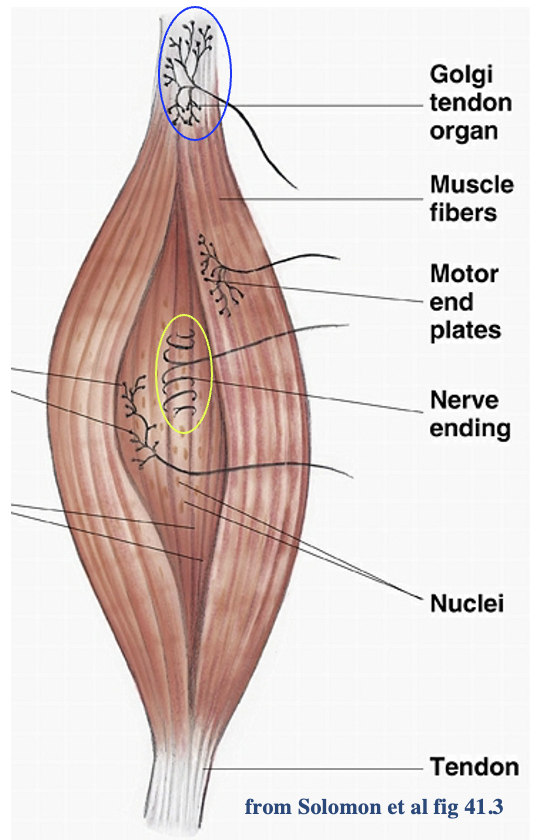
12
New cards
Golgi Tendon Organ
* The **GOLGI TENDON ORGAN** resembles the Ruffini endings and lies within the *muscle tendon* %%immediately beyond its attachment to the muscle fibres%%;
\
* Composed of **connective tissue fibers** surrounded by **dendrites** and encased in a capsule
\
* On average **10 - 15** muscle fibres are connected to each Golgi organ;
\
* The **Golgi tendon organs** detect muscle **tension** whereas the muscle spindles detect relative muscle **length**;
\
* It provides the nervous system with almost instantaneous information on the *degree of tension* on each small segment of each muscle;
\
* The signals from the **two** receptors (Golgi tendon organs and muscle spindles) operate entirely at a **subconscious** level causing **no sensory perception** at all;
\
* Despite this, the information they provide allows the CNS to exactly control and coordinate skeletal muscle contraction;
\
Collagenous, connective tissue capsule filled with nerve endings
\
R slow adaptors
\
* Composed of **connective tissue fibers** surrounded by **dendrites** and encased in a capsule
\
* On average **10 - 15** muscle fibres are connected to each Golgi organ;
\
* The **Golgi tendon organs** detect muscle **tension** whereas the muscle spindles detect relative muscle **length**;
\
* It provides the nervous system with almost instantaneous information on the *degree of tension* on each small segment of each muscle;
\
* The signals from the **two** receptors (Golgi tendon organs and muscle spindles) operate entirely at a **subconscious** level causing **no sensory perception** at all;
\
* Despite this, the information they provide allows the CNS to exactly control and coordinate skeletal muscle contraction;
\
Collagenous, connective tissue capsule filled with nerve endings
\
R slow adaptors
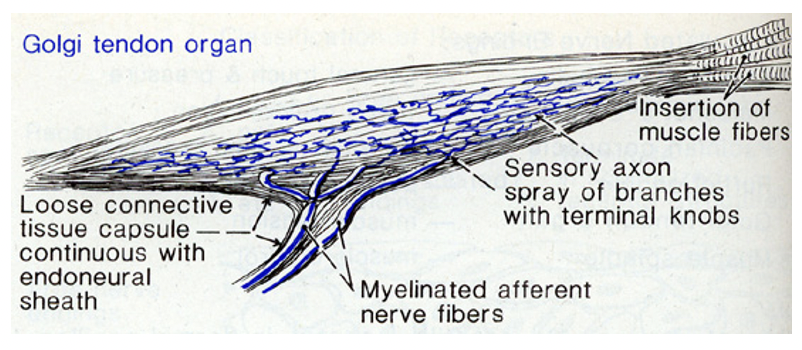
13
New cards
just diagram of dif response times of thalamic neurons/ sensory receptors in intensity over time
Pascinian within miliseconds
\
Joit capsule receptors - e.g. golgi tendon end organs
\
All sentient info travels to ur brain, to thalus (?)
\
Joit capsule receptors - e.g. golgi tendon end organs
\
All sentient info travels to ur brain, to thalus (?)
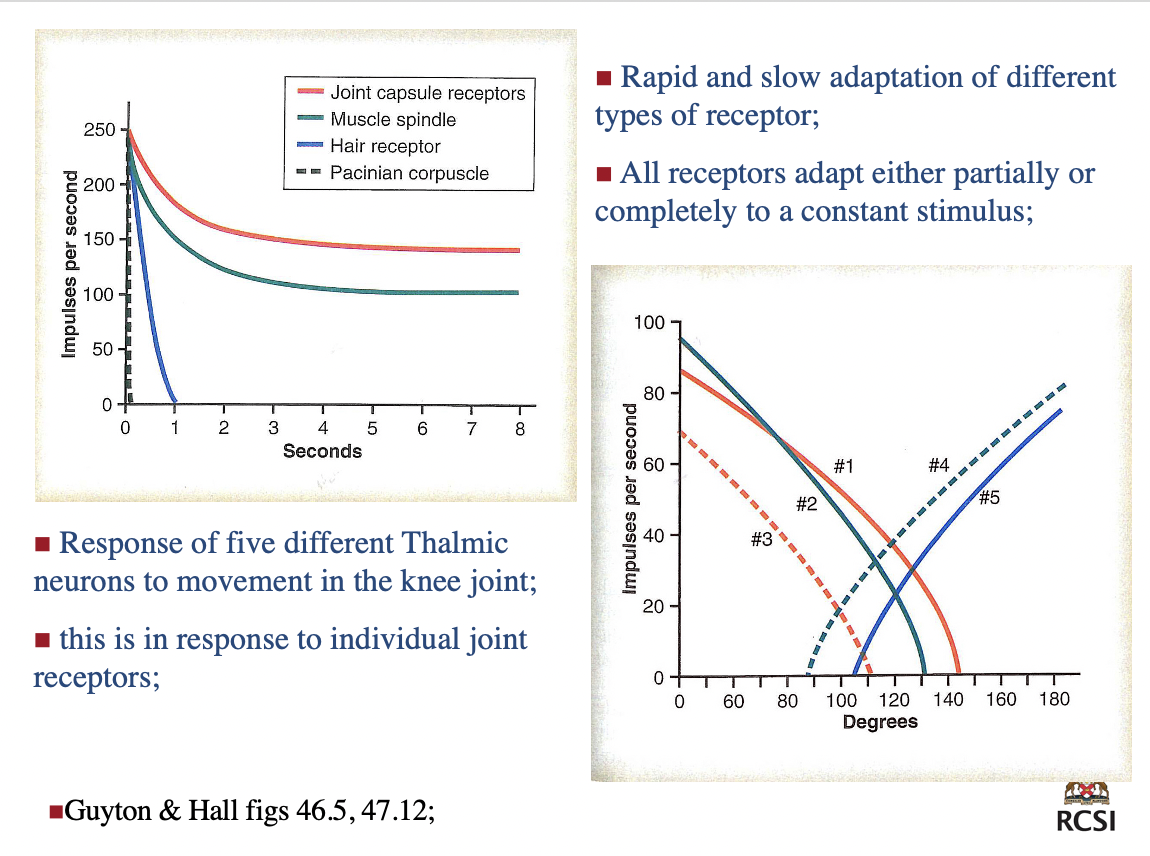
14
New cards
**chemoreceptors**, there are 2 major chemoreceptors, those involved in **taste** and those involved in **smell**
\
**Taste:**
taste buds found where, how many of them r there in humans, composed of which type of cells? stimulated by what? we know mechanoreceptors are stimulated by touch, pinching, pressure, what are chemoreceptors (specifically taste buds) stimulated by?
\
**Taste:**
taste buds found where, how many of them r there in humans, composed of which type of cells? stimulated by what? we know mechanoreceptors are stimulated by touch, pinching, pressure, what are chemoreceptors (specifically taste buds) stimulated by?
* This is sensed by small organs the **taste buds** of the **tongue**;
\
* In humans these number about 3,000 and are located in tiny elevations of the tongue, the **lingual papilla**;
\
* **Taste buds** are composed of about 50 modified epithelial cells which are arranged around a **taste pore**;
\
* Taste buds are stimulated by chemicals in the food we eat and are therefore referred to as chemoreceptors
\
* Taste buds are also found on the roof of the oral cavity, the pharynx, and the larynx, but in smaller numbers
* Classically two types of cell are described from the taste bud (gustatory cells and darker sustentacular cells)
\
All the papillae except 1 contain taste receptors, this other one is involved in making ur tongue a bit rougher this helps us manipulate food in mouth, get traction
\
Taste receptors mostly in tongue but also a few in larynx and pharynx but muuuuuuuuuch less than tongue
\
* In humans these number about 3,000 and are located in tiny elevations of the tongue, the **lingual papilla**;
\
* **Taste buds** are composed of about 50 modified epithelial cells which are arranged around a **taste pore**;
\
* Taste buds are stimulated by chemicals in the food we eat and are therefore referred to as chemoreceptors
\
* Taste buds are also found on the roof of the oral cavity, the pharynx, and the larynx, but in smaller numbers
* Classically two types of cell are described from the taste bud (gustatory cells and darker sustentacular cells)
\
All the papillae except 1 contain taste receptors, this other one is involved in making ur tongue a bit rougher this helps us manipulate food in mouth, get traction
\
Taste receptors mostly in tongue but also a few in larynx and pharynx but muuuuuuuuuch less than tongue
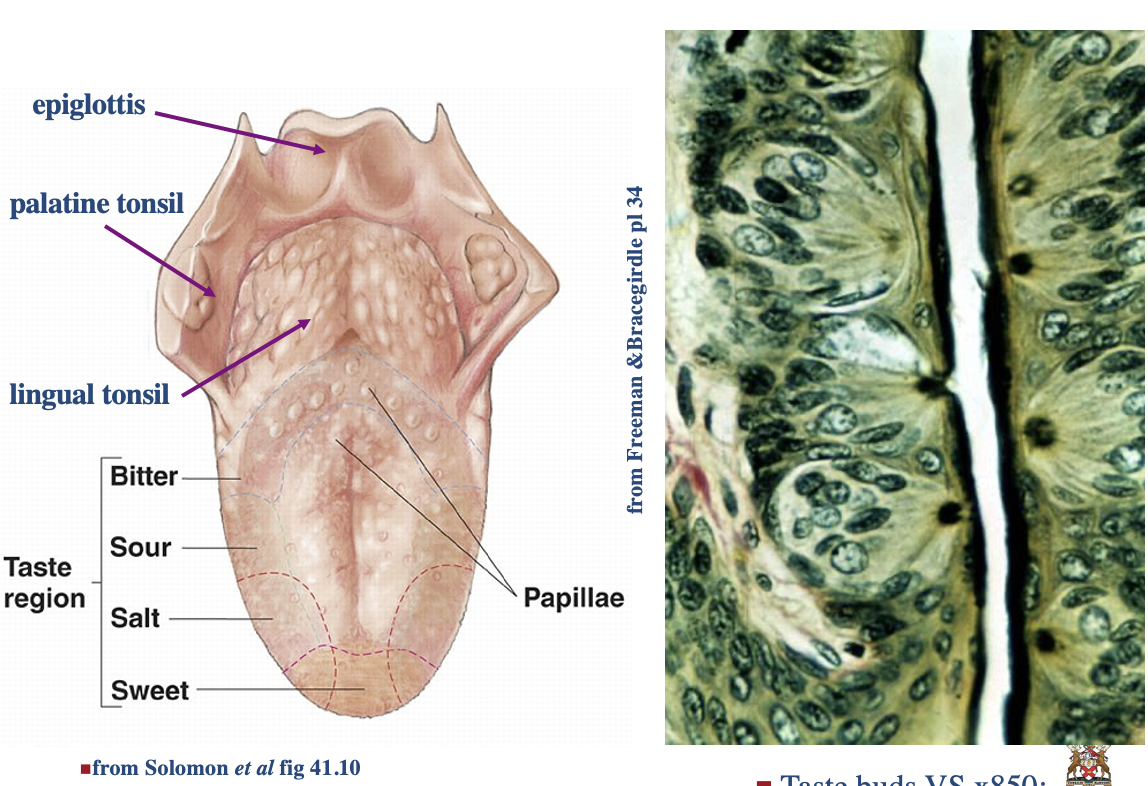
15
New cards
distribution of taste receptors
\
4 primary sensations of taste and what’s the 5th one from 2000s that’s still controversial?
\
4 primary sensations of taste and what’s the 5th one from 2000s that’s still controversial?
4 primary ones are: sweet, sour, salty, bitter
5th is **umami** (glutamate) a velvety presence to food
* every single taste bud can taste all 5 of these
* Each area is said to be occupied by a particular taste bud but it has been shown that all taste buds respond to some extent
* taste and smell work synchronously
* Covid, Cold or allergies - loss of taste. BUT not actually taste buds that are affected- its olfactory sense that is affected and lessens the taste overall
5th is **umami** (glutamate) a velvety presence to food
* every single taste bud can taste all 5 of these
* Each area is said to be occupied by a particular taste bud but it has been shown that all taste buds respond to some extent
* taste and smell work synchronously
* Covid, Cold or allergies - loss of taste. BUT not actually taste buds that are affected- its olfactory sense that is affected and lessens the taste overall

16
New cards
chemoreceptors - taste:
* gustatory cells and darker sustentacular cells
* gustatory cells and darker sustentacular cells
* **Gustatory cells** and darker **sustentacular cells** with a third **basal cell** now recognised which may give rise to both (as in this third basal cell that has been discovered can differentiate into either g cells or s cells);
%%Basal cells maybe are reserved to give rise to new taste receptors and support existing ones%%
\
* Both the gustatory and sustentacular cells have long **microvilli**;
\
* The microvilli or taste hairs protrude into the pore and are the taste receptors;
\
* The plasma membrane of taste hairs contain clusters of *protein molecules*
\
* These receptors bind to *food molecules dissolved in water (saliva)*
\
* Stimulation of the receptor cells causes the stimulation of the **dendrites** of the sensory nerves wrapped around the receptor cells and impulses from the taste bud are transmitted to the brain
\
* **Zinc**- stimulates division of the cells in taste buds
\
* Although the **gustatory cells** are thought to be the %%taste receptors%% the **sustentacular cells** may serve some receptor function;
\
The taste buds are innervated by up to 50 **non-myelinated** nerve fibres which innervate both cells;
\
but they seem to have closer relationship with the**gustatory cells**
\
the **taste buds** on the tongue are continuously bathed in saliva and the taste receptors detect chemicals dissolved in the saliva;
\
certain molecules, such as for example sugar molecules, activate a signal transduction process involving a **G protein**;
%%Basal cells maybe are reserved to give rise to new taste receptors and support existing ones%%
\
* Both the gustatory and sustentacular cells have long **microvilli**;
\
* The microvilli or taste hairs protrude into the pore and are the taste receptors;
\
* The plasma membrane of taste hairs contain clusters of *protein molecules*
\
* These receptors bind to *food molecules dissolved in water (saliva)*
\
* Stimulation of the receptor cells causes the stimulation of the **dendrites** of the sensory nerves wrapped around the receptor cells and impulses from the taste bud are transmitted to the brain
\
* **Zinc**- stimulates division of the cells in taste buds
\
* Although the **gustatory cells** are thought to be the %%taste receptors%% the **sustentacular cells** may serve some receptor function;
\
The taste buds are innervated by up to 50 **non-myelinated** nerve fibres which innervate both cells;
\
but they seem to have closer relationship with the**gustatory cells**
\
the **taste buds** on the tongue are continuously bathed in saliva and the taste receptors detect chemicals dissolved in the saliva;
\
certain molecules, such as for example sugar molecules, activate a signal transduction process involving a **G protein**;
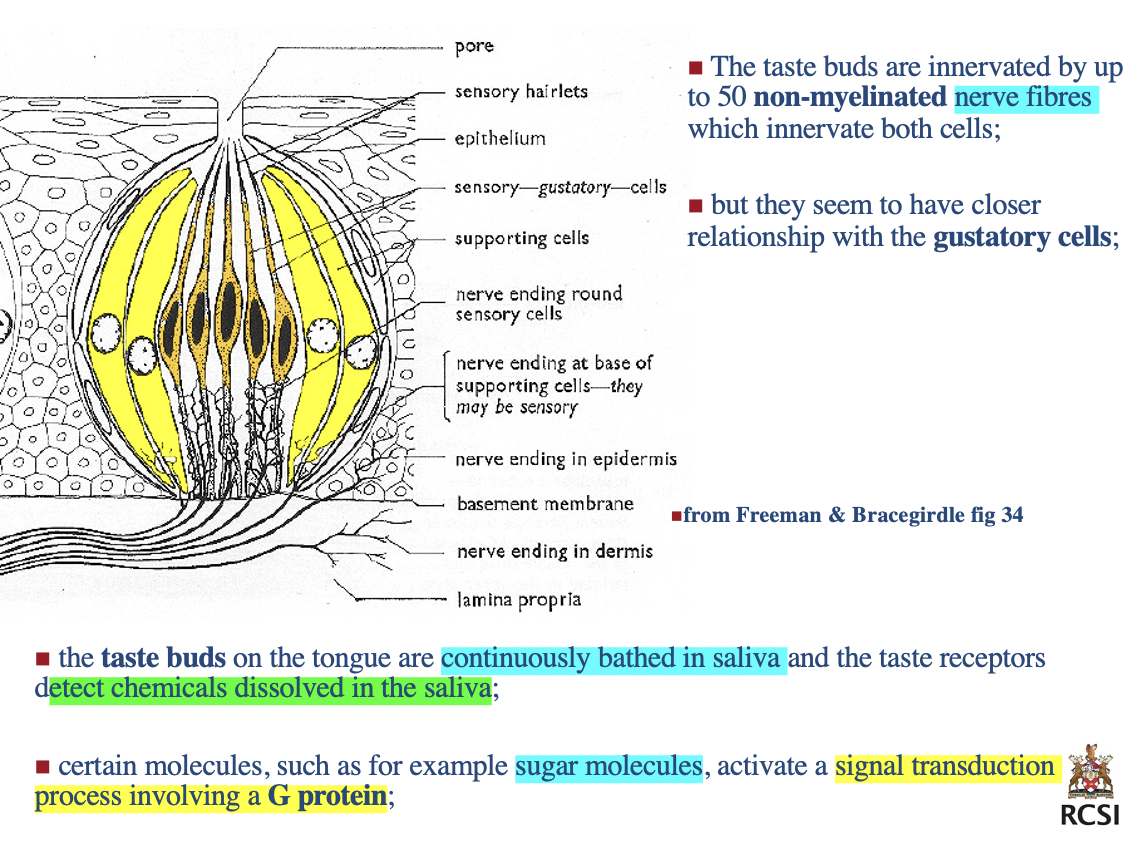
17
New cards
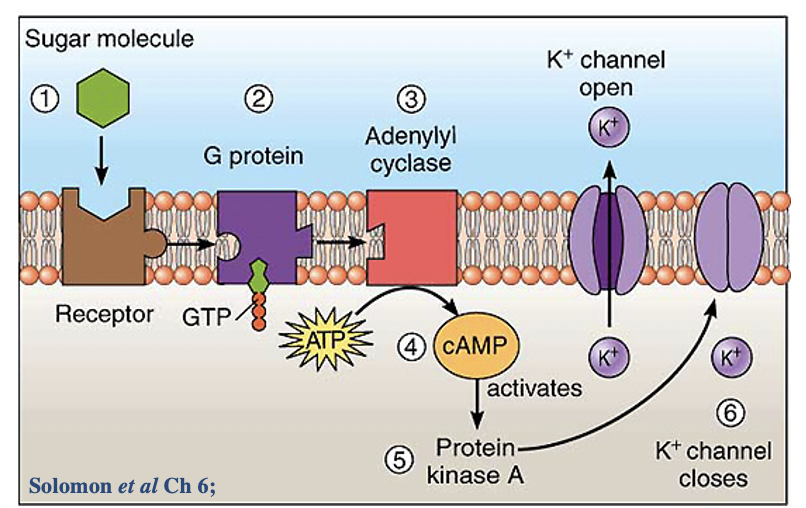
certain molecules, such as for example sugar molecules, activate a signal transduction process involving a **G protein**
\
what happens once the chemical/sugar molecule interacts w the receptor molecule
\
what happens once the chemical/sugar molecule interacts w the receptor molecule
Once the chemical interacts with the receptor molecule a chain of events occurs involving the **G protein** plus **adenylyl cyclase** which increases **cyclic AMP** levels;
\
This in turn activates a **protein kinase** which phosphorylates and closes **K+ ion channels**;
\
Decreased K+ ion permeability sets up a depolarizing receptor potential which generates an action potential in the sensory neuron
\
This in turn activates a **protein kinase** which phosphorylates and closes **K+ ion channels**;
\
Decreased K+ ion permeability sets up a depolarizing receptor potential which generates an action potential in the sensory neuron
18
New cards
chemoreceptors → **olfactory sense!**
moving away from taste, what’s the olfactory epithelium
moving away from taste, what’s the olfactory epithelium
* The olfactory epithelium is %%a patch of receptor cells in the roof of the nasal cavity that detects odors%%
\
* In many tetropods and particularly mammals the sense of **smell** is the main source of information concerning the outside world;
\
* We tend not to be conscious of this as ==__the human sense of smell is very poorly developed__==;
\
* The **olfactory membrane** lies in the *upper part of each nostril* where it is folded over the **turbinal bones** giving a surface area of 2.4 cm2 in each nostril;
\
* In many tetropods and particularly mammals the sense of **smell** is the main source of information concerning the outside world;
\
* We tend not to be conscious of this as ==__the human sense of smell is very poorly developed__==;
\
* The **olfactory membrane** lies in the *upper part of each nostril* where it is folded over the **turbinal bones** giving a surface area of 2.4 cm2 in each nostril;
19
New cards
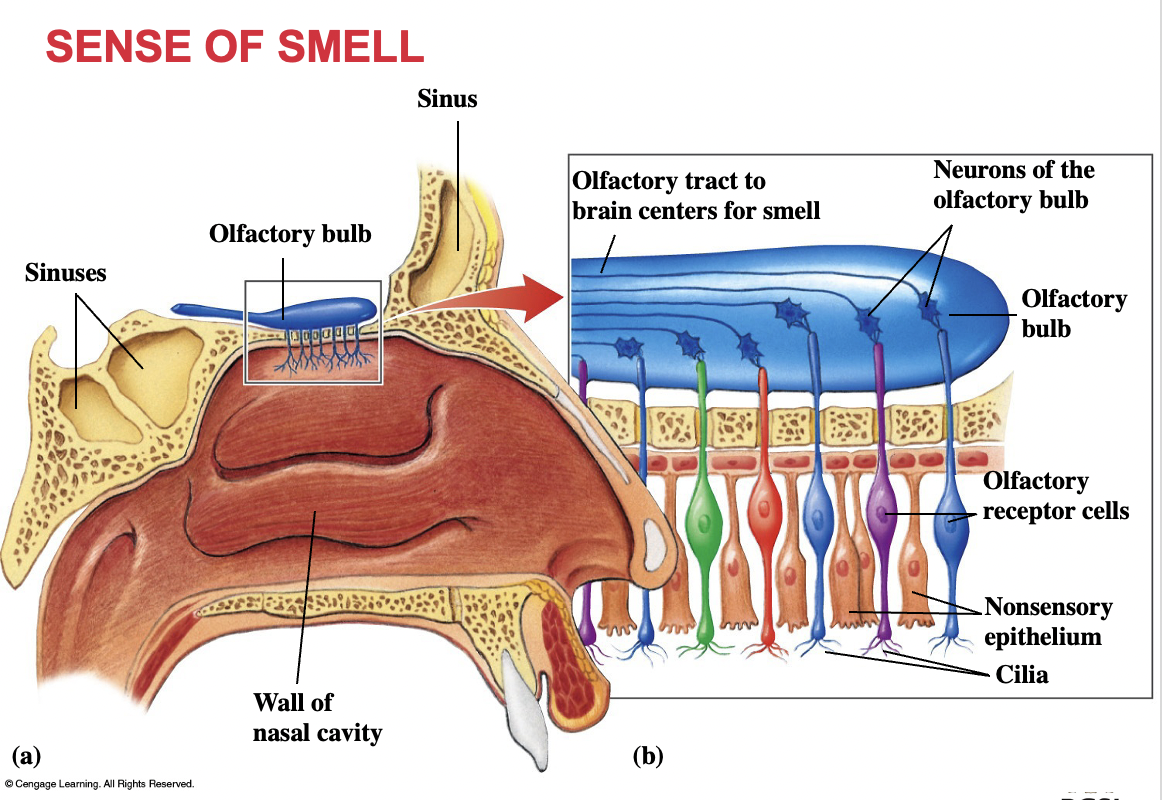
olfaction
how many olfactory receptor cells in the olfactory membrane?
how many olfactory receptor cells in the olfactory membrane?
* The olfactory membrane contains about 100 million olfactory receptor cells;
\
* The **olfactory cells** themselves are quite simple structures contained within the columnar epithelium of the **mucus membrane**;
\
* Once more there are three cell types: %%**olfactory receptor cells**, **sustentacular cells** and%% @@**basal**@@ %%**epithelial cells**%%;
\
* The olfactory receptor cells are true **BIPOLAR NEURONS** whose cell body is located in the **middle stratum** of the mucosa;
\
* The axons of the sensory neurons pass through about *20 small holes* on each side of the cribiform plate of the **ethmoid bone** and enter the **olfactory bulb in the brain;**
\
**Figure 43-15 Chemoreception: olfaction**
(a) Location of olfactory receptor cells. Smell depends on thousands of chemoreceptor cells in the roof of the nasal cavity.
(b) The olfactory receptor cells. These receptors are neurons located in the olfactory epithelium.
\
* The **olfactory cells** themselves are quite simple structures contained within the columnar epithelium of the **mucus membrane**;
\
* Once more there are three cell types: %%**olfactory receptor cells**, **sustentacular cells** and%% @@**basal**@@ %%**epithelial cells**%%;
\
* The olfactory receptor cells are true **BIPOLAR NEURONS** whose cell body is located in the **middle stratum** of the mucosa;
\
* The axons of the sensory neurons pass through about *20 small holes* on each side of the cribiform plate of the **ethmoid bone** and enter the **olfactory bulb in the brain;**
\
**Figure 43-15 Chemoreception: olfaction**
(a) Location of olfactory receptor cells. Smell depends on thousands of chemoreceptor cells in the roof of the nasal cavity.
(b) The olfactory receptor cells. These receptors are neurons located in the olfactory epithelium.
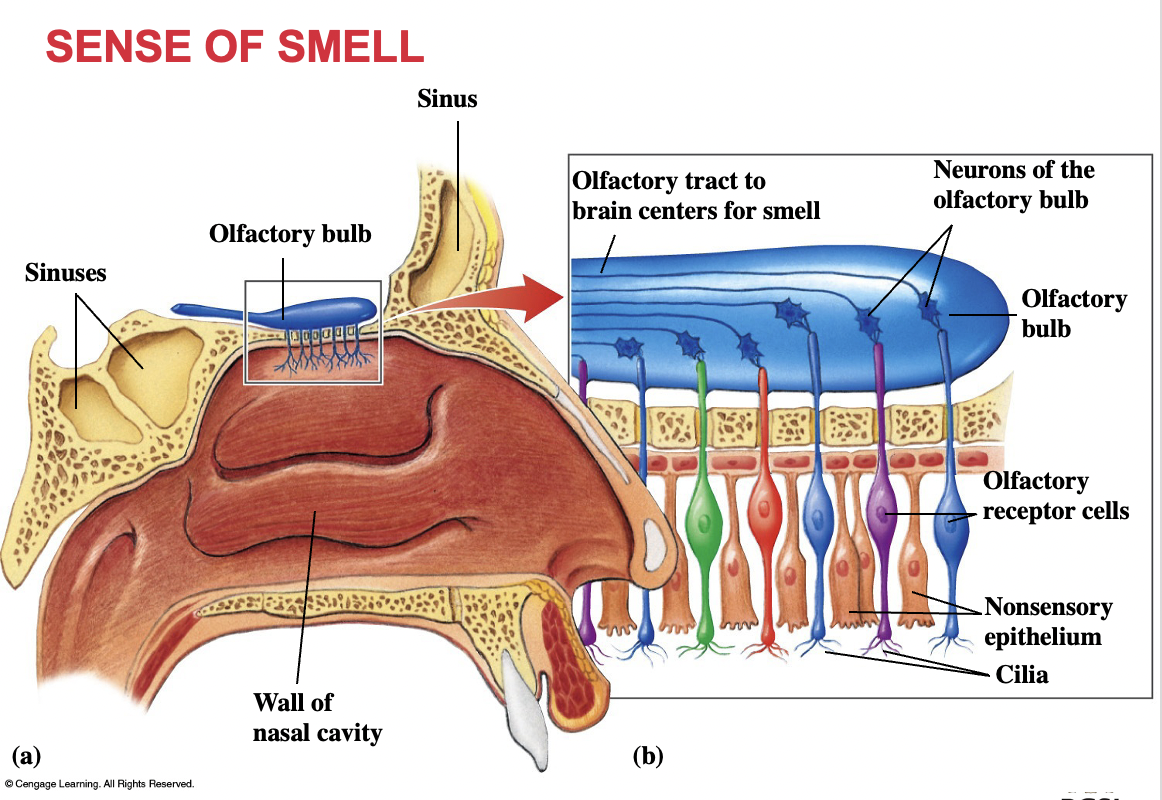
20
New cards
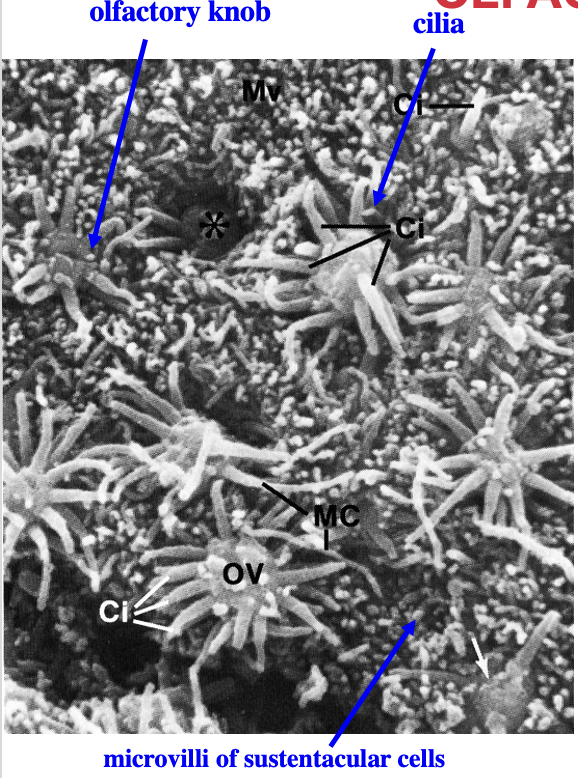
Olfactory mucosa
* A single **dendritic** process extends from the **soma** to the free surface where it terminates as a small swelling the **olfactory knob**;
\
* From the **olfactory knob** a dozen or so **cilia** or **olfactory hairs**(50 - 150 mm long) project outward;
* Each cell gives rise to single **non-myelinated axon;**
* These join up with others to pass through the bone to reach the **olfactory bulbs** of the **Forebrain**;
* unmyelinated speed of conduction is very slow
\
* From the **olfactory knob** a dozen or so **cilia** or **olfactory hairs**(50 - 150 mm long) project outward;
* Each cell gives rise to single **non-myelinated axon;**
* These join up with others to pass through the bone to reach the **olfactory bulbs** of the **Forebrain**;
* unmyelinated speed of conduction is very slow
21
New cards
olfactory process
what are the chemoreceptors?
what are the chemoreceptors?
* The role of the **SUSTENTACULAR CELLS** is poorly understood, they have long **microvilli** but are probably mostly concerned with mechanical and physiological support;
\
* The **cilia** are the **CHEMORECEPTORS** and react to odours in the air stimulating the olfactory cells;
\
* This process may be similar to the process in the **taste buds** with a molecule **receptor**, a **G protein**, adenylyl cyclase and **cyclic AMP**;
\
* the **cyclic AMP** opens **gated channels** in the receptor membrane;
\
* the opening of **Na+ ion** channels allows Na+ ions and other cations to enter the cell causing depolarization and an action potential;
\
* The **cilia** are the **CHEMORECEPTORS** and react to odours in the air stimulating the olfactory cells;
\
* This process may be similar to the process in the **taste buds** with a molecule **receptor**, a **G protein**, adenylyl cyclase and **cyclic AMP**;
\
* the **cyclic AMP** opens **gated channels** in the receptor membrane;
\
* the opening of **Na+ ion** channels allows Na+ ions and other cations to enter the cell causing depolarization and an action potential;
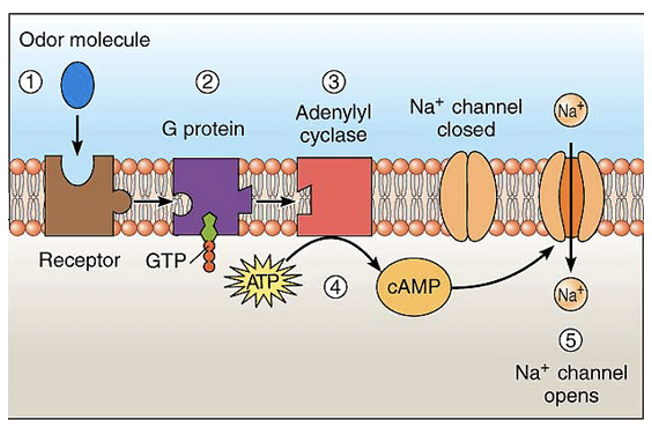
22
New cards
olfactory sense - classically human are said to detect 7 main classes of odours:
\
but please explain the craziness and nuance of odours wer able to detect bc of what odours are composed of. . .
\
but please explain the craziness and nuance of odours wer able to detect bc of what odours are composed of. . .
\
* **Camphor**, **musk**, **floral**, **peppermint**, **ethereal**, **pungent** and **putrid**;
\
* About 1000 genes code for 1000 types of olfactory receptor;
\
* *Odours are usually* @@***composed of several chemical components***@@ *and each type of receptor may bind with a particular component!!!!*
\
* *The* @@*combination of receptors activated determines the odour perceived*@@*!!!! as a consequence we can distinguish between up to 10,000 different scents!!!!*
\
\
%%If stimulus isnt changing ur environment then the brain doesn’t need to know. Is on a need to know basis, need to know. When things change, get back to it. Itll need to know.%%
* **Camphor**, **musk**, **floral**, **peppermint**, **ethereal**, **pungent** and **putrid**;
\
* About 1000 genes code for 1000 types of olfactory receptor;
\
* *Odours are usually* @@***composed of several chemical components***@@ *and each type of receptor may bind with a particular component!!!!*
\
* *The* @@*combination of receptors activated determines the odour perceived*@@*!!!! as a consequence we can distinguish between up to 10,000 different scents!!!!*
\
\
%%If stimulus isnt changing ur environment then the brain doesn’t need to know. Is on a need to know basis, need to know. When things change, get back to it. Itll need to know.%%
23
New cards
summary for sensory receptors
* cellular, encapsulated or free nerve ending?
x
* thermo?
* noci?
* photo?
* chemoreceptors?
* cellular, encapsulated or free nerve ending?
x
* thermo?
* noci?
* photo?
* chemoreceptors?
\